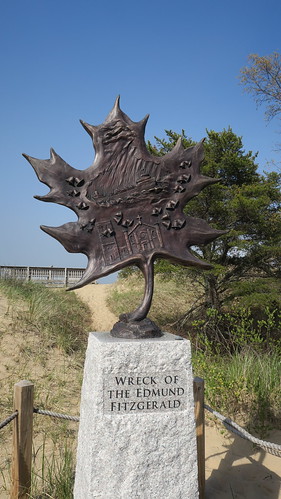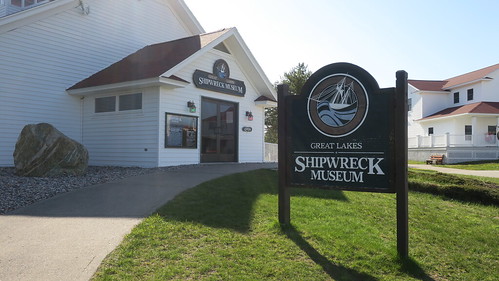Shipwrecks of the Great Lakes: The S.S. Edmund Fitzgerald
The approximate 6,000 ships that have succumbed to raging storms attest to the power of the Great Lakes. As I traveled, writing and compiling information for my three-volume travel series, Exploring Michigan’s Coasts, I heard or read the tales left behind by those ill-fated ships. They add a somber, but compelling backdrop to Michigan’s waterways.

The legend lives on from the Chippewa on down of the big lake they call Gitche Gumee
The S.S. Edmund Fitzgerald, immortalized by Gordon Lightfoot in his ballad, “The Wreck of the Edmund Fitzgerald,” remains alive in the imaginations of Michiganders nearly a half century after she sank.

Great Lakes Shipwreck Museum entry to the beach with the leaf sculpture with engraving of the SS Edmund Fitzgerald
When launched in 1958, the Mighty Fitz, at 729 feet (more than the length of 2½ football fields), was the largest freighter on the lakes. She spent her working days hauling iron ore from mines near Duluth, Minnesota, to manufacturers in Detroit, Michigan, and Toledo, Ohio.

Photo Wikimedia Commons: United States Army Corps of Engineers
As strong and vital as she was, this Titanic of the Great Lakes was no match when the Witch of November came calling. On November 10, 1975, the Fitzgerald succumbed to Superior’s immense rage. What took her down remains debated by experts and amateur sleuths alike, although all agree the weather and 35-foot waves played major roles. The United States Coast Guard’s official report cited the cause of the wreck as faulty hatch covers that allowed massive flooding of the cargo hold. Other hypotheses include the possibility the ship hit a shoal, that it carried too much cargo, or that it suffered structural problems.
Whatever the reason for her trouble, the captain radioed a message that he had a serious problem, was listing, had lost his radar, and the storm was coming for him. His last transmission was, “We are holding our own.” The next five minutes proved him wrong as the Fitzgerald began her agonizing descent. By the time she hit bottom, she had broken in two.
Rare radio chatter between the Arthur M. Anderson and the Coast Guard November 10th, 1975. The last time anyone ever heard from the Edmund Fitzgerald.
The frenzied hurricane hurled 29 men to their watery grave. Not a single body was recovered. A 1994 expedition of divers to the wreck found a body, fully-clothed, face down in the sediment near the bow of the ship. The deceased was left undisturbed where he lay. Some critics felt the remains should have been brought up to give the family closure. With modern technology, retrieval should be possible for at least some of the bodies still down there.
The families opposed bringing them up. They know where their loved ones are and feel that closure is not an issue. They don’t want the dead torn from their final resting place in the company of the crewmates with whom they shared their tragic last minutes.
It is believed that if the Fitzgerald could have made another 15 miles, she’d have survived. That’s how close she was to the protection of Whitefish Bay.

Photo Wikimedia Commons: Deb Nystrom at the Great Lakes Shipwreck Museum at Whitefish Point
The Great Lakes Shipwreck Museum
A must-visit museum if you are traveling through the Upper Peninsula, the museum brings to life the story of ships that crossed paths with one of the most treacherous shipping channels on the Great Lakes.

The video theatre provides a short film documenting the sinking of the Edmund Fitzgerald and the efforts that raised her 200-pound bell and made it part of the museum.
The museum grounds also are home to Whitefish Point Light Station, Keepers Quarters, and the Whitefish Point Bird Observatory.

Click through to read excerpts from Royce's three books exploring Michigan's coasts:
Julie Albrecht Royce, the Michigan Editor for Wandering Educators recently published a three-book travel series exploring Michigan’s coastlines. Nearly two decades ago, she published two traditional travel books, but found they were quickly outdated. This most recent project focuses on providing travelers with interesting background for the places they plan to visit. Royce has published two novels: Ardent Spirit, historical fiction inspired by the true story of Odawa-French Fur Trader, Magdelaine La Framboise, and PILZ, a legal thriller which drew on her experiences as a First Assistant Attorney General for the State of Michigan. She has written magazine and newspaper articles, and had several short stories included in anthologies.
The books are available at Amazon.
Word photo: Photo Wikimedia Commons: US Coast Guard, adapted by Wandering Educators






















